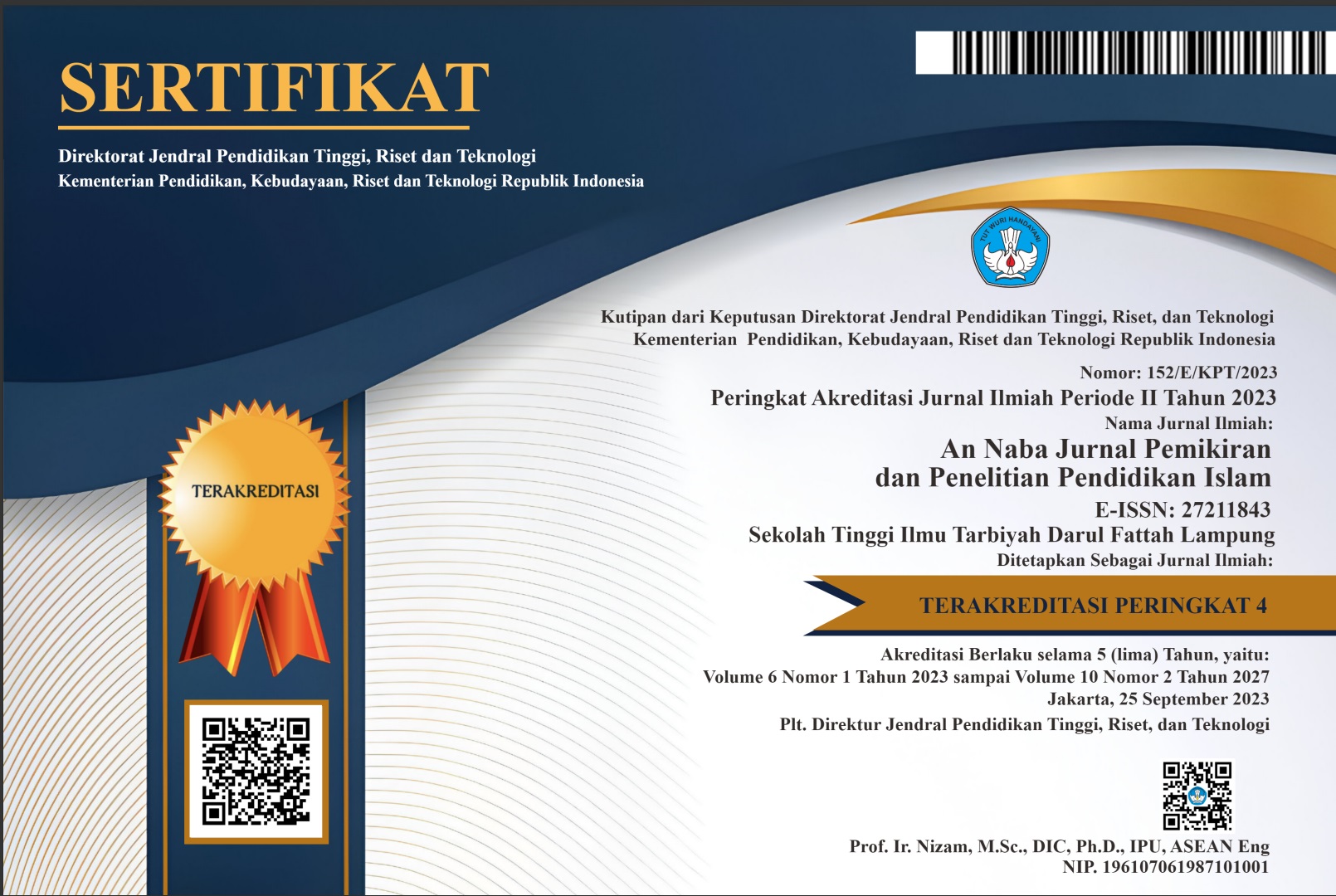Analisis Sintaksis Majrurat Al-Asma Dalam Surat Yasin
DOI:
https://doi.org/10.51614/annaba.v5i2.158Keywords:
Majurat al-asma, Arabic Grammar, Surah YasinAbstract
Majrurat al-asma is part of the material contained in Arabic grammar. It is still rarely discussed and indicated by the fact that many Arabic students only know that majrur only caused by the inclusion of the letter jar and the sign of majrur is only kasroh, even though there other reasons for majrur are being idhofah and caused to being tawabi'. There are other signs of majrur not only kasrah but also ya and fathah as a substitute for kasroh. The research on majrurat al-asma has been widely used as a tool in researching Arabic, both in studying ancient manuscripts and Surahs of the Qur'an. While the researchers themselves want to study more about majrurat al-asma, one of Surah in the Qur'an is Surah Yasin. Surah Yasin is the 36th surah of the Quran and was revealed in the middle period in Mecca (before the hijrah), so it belongs to the Makkiyah surah group. This surah consists of 83 verses. However, the fact that it happened in Indonesia found that Yasin was the most frequently read letter after Al-Fatihah, Al-Ikhlas, Al-Falaq, and An-Nas. The research is a library research. The literature study in question is trying to study linguistic theory or linguistic studies. Where researchers browse, analyze data through the literature. The results of this study indicate that The signs of I'rob jar in the Al-Qur'an letter Yasin include: Kasroh which consists of isim mufrod 69 data, jama’ taksir 13 and jama’ muannas salim 1 data. Ya there are 3 data. Fathah amounted to 1 data. In the form of masdar muawwal 1 data, isim maushul 7 data and 69 legal data are mabni.
Keywords: Majurat al-asma, Arabic Grammar, Surah Yasin
References
Al-Qur’anul Karim
Abu & Ummu Razim. 2015. Ilmu Nahwu Untuk Pemula. Pustaka Bisa.
Abu Ahmad Al Mutarjim. 2015. Terjemah Kitab Mulakhkhosh Qowa’idul Al-Lughota Arabiyah. Beirut: Daarust-tsaqofi al-islamiyyah.
Abu Hamzah Yusuf Al-Atsary. 2007. Pengantar Mudah Belajar Bahasa Arab. Bandung: Pustaka Adhwa.
Acep Hermawan. 2013. Metodologi Pembelajaran Bahasa Arab. Bandung: Rosdakarya.
Agustiar. 2016. Kaidah-Kaidah Dasar Memahami Bahasa Arab. Riau: Asa Riau.
Ahmad Chodjim. 2008. Menerapkan Keajaiban Surah Yasin dalam Kehidupan Sehari-hari. Jakarta: PT Serambi Ilmu Semesta.
Ahmad Izzan. 2011. Metodologi Pembelajaran Bahasa Arab. Bandung: HUMANIORA.
Albi Anggito & Johan Setiawan. 2018. Metodologi Penelitian Kualitatif. Jawa Barat: CV Jejak.
Amroeni Drajat. 2017. Pengantar Ilmu-Ilmu Al-Qur’an Edisi Pertama. Depok: Kencana.
Burhan Bungin. 2005. Metodologi Penelitian Kuantitatif Edisi Kedua. Jakarta: Kencana.
Department Agama RI. 2015. Surat Yasin Tajwid Warna Tahlil & Istighasah. Jakarta: Shahih.
Dyah Rovita Sari. 2012. Huruf Jar Dalam Al-Qur’an Surat Muhammad. Universitas Negeri Semarang.
Kamil Ramma Oensar & Ahmad Hifni. 2015. Pengantar Metodologi Pembelajaran Bahasa Arab. Kalimantan Selatan: IAIN Antasari Press.
Mestika Zed. 2004. Metode Penelitian Kepuastakaan Edisi Pertama. Jakarta: Yayasan Obor Indonesia.
Moh.Fahrun. 2019. Tafsir Yasin Hamami. Surabaya: Maktabah Al-Hidayah.
Muhammad Said. 2008. Pesona Surat Yasin. Jakarta: Gema Insani.
Muri Yusuf. 2014. Metode Penelitian: Kuantitatif, Kualitatif Dan Metode Gabungan. Jakarta: Kencana.
Rusdianto. 2018. Cepat Dan Mudah Belajar Bahasa Arab. Yogyajarta: Laksana.
Rusdianto. 2019. Bahasa Arab Autodidak 3. Yogyakarta: Diva Press.
Tsabit Bin Sa’id Al-Wushabi. 2016. Terjemahan At-Tuhfatul Wushabiyyah Fi Tahsil Matn Al-Jurumiyyah. Google Books: Maktabah Ismail Bin Isa.
Basse Wahida. Majrurat Al-Asma dalam Surah Al-Kahfi (Studi Analisis Sintaksis). Jurnal. (tanpa tahun). Diakses di https://jurnaliainpontianak.or.id/index.php/alhikmah/article/download/83/77 [tanggal 26 Juli 2021]














.png)




